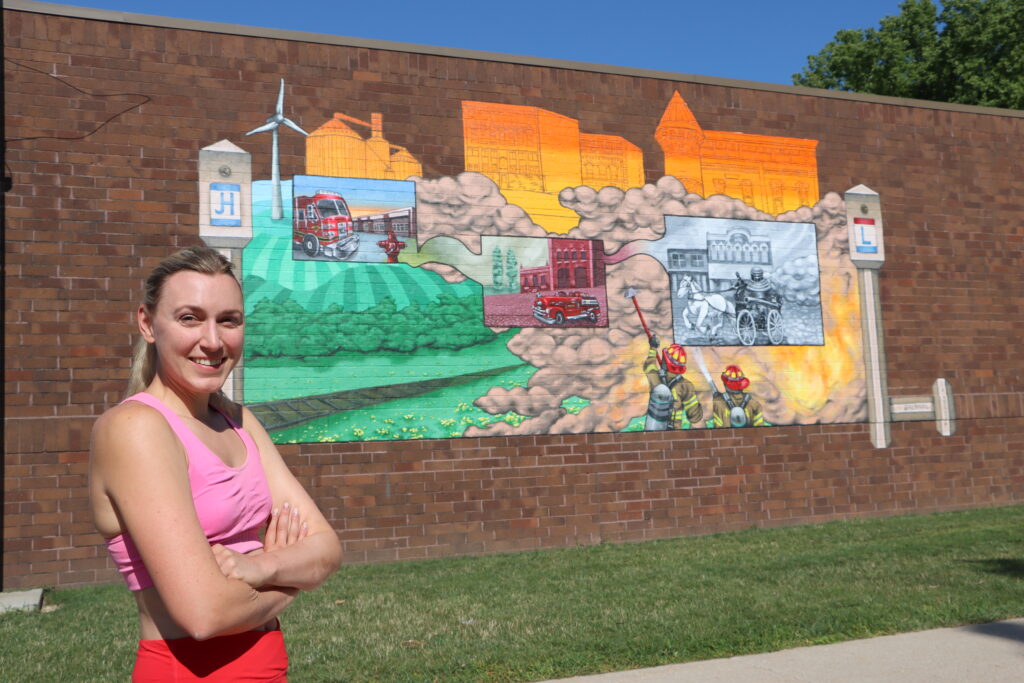Nevada residents were treated to watching a mural happen in real time this summer as the talented Ali Hval worked on “A Transition Through Time” on the east exterior fire station wall.
Her work, while in progress, attracted onlookers, cheers, and interest from young and old alike.
“Everyone’s been really supportive,” said Hval, when she visited about the work on July 18, while standing on a lift, which was provided so she could easily reach all parts of the mural. “Some people shout out to me as they’re driving by … and so far, no haters,” she added with a smile.
Hval is an Alabama native who has been doing murals for the past seven years. She’s completed around 50 murals, usually during summer months when she’s on break from her work as an arts lecturer at the University of Iowa.
Mural work started, she said, when she was in grad school at the U of I and needed money. “One of my friends was going to have me help her with a project, and then she couldn’t do it, so it fell to me.” And from there, “it kind of became my career.”
When deciding on her future, Hval knew she wanted to be an art professor, but she admits she didn’t think painting murals was a possibility. “I just didn’t think being a muralist was a job.”
But it is a job, and her skills are in high demand. She is usually working on three or four bigger murals each summer (and Nevada’s mural is definitely in the bigger category) along with several smaller murals. Her work for the owner of Elray’s, a popular bar of undergraduates in Iowa City, led to more work. She painted a neon sign mural on the exterior wall of Elray’s, and then the owner requested her for other businesses he owned. She traveled for him to other states, one of which was Florida in the winter. She didn’t mind that trip at all.
Nevada Fire Chief Ray Reynolds saw her work in Iowa City and then looked online to find her. She has a social media presence, as well as a website. She also signs each public art piece helping people more easily find her by name.
She came to Nevada earlier in the year to talk with Reynolds, see the fire station, and learn more about the ideas Reynolds had for the mural.
Development to Reality
Taking what Reynolds was thinking and then coming up with how a mural would look is part of the creative process that Hval said usually plays out in her head for several weeks. Like other creative people, her best ideas come to her while she’s in the shower or going on a run. “I can never really rush the creative process, and that’s the hardest part,” she said, noting that she’ll draw concepts out from her thoughts. “Painting is the easiest part” of a project, she noted.
For some murals, she can use a projector to outline the work on a wall. For Nevada’s project, because of how it was shaped, she carefully measured it on a diagram. “I started with a rectangle and then broke it down into thirds.” Then she worked to determine what elements would go into each “third” of the project.
Earlier in the summer, she put primer on the bricks, which is a very important part of the project. “It’s a concrete masonry primer of really high quality that adheres well to the wall and provides a good surface. You want a really white surface to paint on, especially when you’ve got a lot of these really transparent colors like the yellow and orange.”
She sketched some of the concept in blue, which is what people saw until she returned to paint.
For Hval, the Nevada Fire Station’s brick, is about “medium difficulty” in terms of surfaces to paint on. The primer helps with the surface, by filling in some of the little holes. The paint Hval uses is a high-quality mural paint she has shipped out of California.
“It is very light-fast, so it won’t fade like other paints. This paint doesn’t have a lot of other colors mixed into it; it’s highly pigmented and very pure, so your red is going to be as red as it can be, and when you mix that with another color, it’s not going to be diluted by any other colors. This keeps it really rich and vivid,” she explained.
Her favorite thing to paint in the Nevada mural was the fire. “I was a little nervous about it, because I hadn’t painted fire before. I’ve done clouds and smoke, but I didn’t know how this fire was going to turn out. But it was actually the easiest thing.”
As for the entire piece and what she loves about it is all the Nevada elements that are tied into it from railroad tracks to local architecture. “Ray talks about it being like a little treasure hunt,” she said.
When she finished the painting, Hval went over the entire piece with a matt varnish, which helps even out the tone and protect the paint. It also has something in it to protect from UV rays.
The life span of this piece of public art is hard to say. “They can last forever if you take care of them,” Hval said. “I have murals that are seven or so years old now, and they’ve faded a bit, but others can’t really tell. People may start to notice this is fading after 10 years, but I don’t think it will be that noticeable.”
The City has been on a mission this year to give public arts an emphasis in the community. As an artist, Hval is, of course, in favor of this endeavor. “Public arts is important because everybody can connect with it. A lot of times, people think art is only for those who can afford to go to an art gallery … but something like this makes art for everybody. It’s also good for place-making, and for giving directions. How many times have you been lost in a city, but you recognize a piece of art or a landmark. You can get your bearings from this, and (last but not least) it helps brighten places. Suddenly people want to go there and take photos or see it!”
To view more of Ali Hval’s work, visit her website: alihval.com. You will find Nevada’s finished work and more under the “Public Art” link!
–Written by Marlys Barker, City of Nevada





